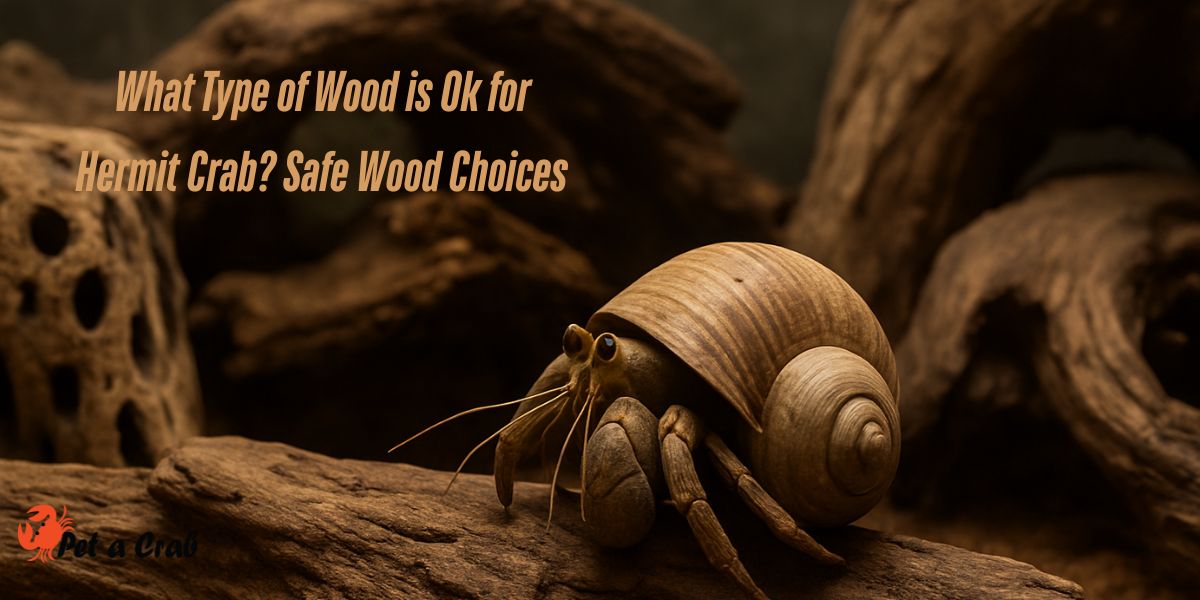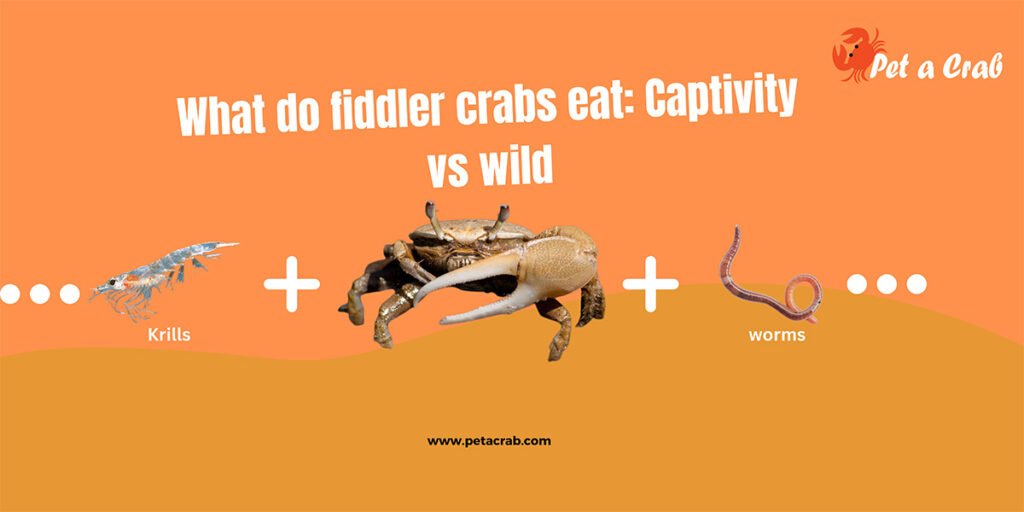As a owner of a hermit crab pet, you want to give your little buddies the best environment possible. But have you ever asked yourself, what type of wood is ok for hermit crabs? Not all woods are the same, some will emit poisonous chemicals, while others are perfect for climbing and hiding. Let’s talk about the safe wood for hermit crabs and how they promote a healthy hermit crab habitat!

What Type of Wood is Ok for Hermit Crabs?
When designing a habitat, ask yourself: What wood is safe for hermit crabs? It is very important to use non-toxic and untreated wood for hermit crabs because they will climb on it, hide in it and be nutritionally enriched by it. The woods safe for hermit crab cages are the following:
Cholla Wood For Hermit Crabs
Cholla wood is also the best wood to use for hermit crabs. Its hollow, porous center provides climbing room, protection and a chewing and digestion-safe surface.
Cork Bark
Cork bark is perfect since it’s soft, flexible and mold-resistant. It creates a naturalistic environment while insulating and retaining moisture, causing the habitat to remain humid and cosy.
Mangrove Roots
The mangrove roots make an excellent choice because they replicate hermit crab coast habitat where these creatures reside naturally. They are durable, water-resistant, and promote climbing, making them a functional and beautiful decoration for the enclosure.
Grapevine Wood
Grapevine wood is a safe option that is light in weight but strong, allowing the hermit crabs to climb, perch, and explore. It beautifies the enclosure while enriching the environment.
Malaysian Driftwood
Unlike other types of driftwood that will leach harmful tannins, Malaysian driftwood is a durable and hermit crab-safe option. It holds humidity and provides a natural ambience to the setup.
Mopani Wood
Most people ask, “Is Mopani wood safe for hermit crabs?” While Mopani wood is extremely hardy and attractive, it contains high tannin levels that can alter water chemistry. If you do wish to use it, ensure that it is boiled and soaked thoroughly to leach out excess tannins before adding it to the terrarium.
Related Topic: Hermit Crab Safe Plants
What Type of Wood is NOT OK for Hermit Crabs?
The wrong kind of wood could be dangerous for hermit crabs since it can expose them to chemicals, toxins, or toxic oils. Some of the dangerous types of wood are:
Pine
Is pine toxic to hermit crabs? Yes, pine wood particularly scented or treated wood is extremely toxic to hermit crabs. It brings natural oils and resins that are strong enough to release harmful fumes, even triggering respiratory issues or poisoning.
Pressure-Treated Wood
Treated with chemicals that can leach into the environment, creating much injury to your hermit crab.
Painted or Stained Wood
Stains and paints contain toxic chemicals as well that are dangerous to hermit crabs when ingested.
Pesticide-Treated Wood
Pesticides can leave harmful chemicals in your hermit crab’s tank, which can harm them.
Why Wood Selection Matters for Hermit Crabs
Selecting the right type of wood for hermit crabs is a vital aspect of enclosure design that will influence their behavior, health, and well-being. The wrong choice can add toxins, disrupt humidity levels, and pose grave health risks. Here’s why wood selection matters:
Preventing Toxic Exposure
Some woods, including pine, cedar, and oak, contain natural oils, resins, or tannins that are toxic to hermit crabs. The chemicals induce respiratory issues, shell irritation, and poisoning death if ingested or inhaled repeatedly.
Maintaining Humidity and Habitat Conditions
Hermit crabs like humid environments. Secure woods like cholla wood, cork bark, and mangrove roots are moist and create an ideal environment that prevents dehydration and stress.
Encouraging Natural Behavior
Hermit crabs enjoy climbing, digging, and foraging. With proper wood selection, it enriches their habitat, delivering naturalistic climbing objects, areas to hide, and enrichment opportunities to replicate their natural coastal habitats.
Prevention of Mold and Bacterial Growth
Certain woods rot easily or grow mold in humid conditions, which can be detrimental to hermit crabs. Selecting naturally resistant woods, such as grapevine and driftwood, dissuades fungal and bacterial contamination.
Do Hermit Crabs Eat Wood?
Yes, hermit crabs consume wood, but not in the way you might imagine. They don’t simply consume chunks like other animals that eat wood; instead, they chew it to extract the nutrients, particularly cellulose and nutrients beneficial for them.
Why Wood is Important in Their Diet
Wood plays a critical role in a hermit crab’s diet through the provision of essential nutrients to aid digestion and general health. Cholla wood, cork bark, and mangrove wood are safe woods that act as a natural source of fiber and tannins. Wood chewing also helps their exoskeleton repair and maintains them active with normal foraging activities.
How to Use Hermit Crab Safe Wood for Climbing and Hiding
Incorporate the wood into your hermit crab’s habitat respectfully.
Climbing: Place sturdy branches or manzanita wood sections at different angles and heights to create climbing paths. This stimulates exercise and mental activity for your hermit crab.
Hiding: Give hermit crabs pieces of cork bark or safe woods to establish shaded, secluded areas where hermit crabs can withdraw when they require privacy or need to rest.
Related Topic: What Shells Do Hermit Crabs Use?
Hermit Crab Habitat Setup with Wood
Offering your hermit crab its perfect home means more than selecting the right wood, it’s creating a space that invites natural behavior. From sterilization to safe exploration, here’s how to do it.
How to Set Up a Hermit Crab Cage with Safe Wood
Sterilize and Clean The Wood
Prior to placing any wood in your hermit crab tank, it must be thoroughly cleaned to remove dirt, bacteria, and potential pests. This can be done by boiling or baking the wood in a low oven to sterilize it.
Check Sharp Edges or Contaminants
Once sterilized, check the wood for any rough edges or splinters that may injure your hermit crab. Sand away any rough places carefully and ensure the wood is smooth.
Arrange the wood for natural behaviors
Set the wood in the enclosure to create a natural environment. Pile up wood to act as climbing surfaces along with cover places.
Note: If you’re fascinated by the Native American Crab Myth, take a journey through the myths by visiting this guide.
Final Thoughts
In summary, providing your hermit crab with untreated, safe wood is the hub of a well-balanced habitat. Cholla and cork bark are two such readily available choices that also encourage natural behaviors like climbing and hiding. Understanding what type of wood is ok for hermit crabs will set you up for success in a healthier environment.
Frequently Asked Questions
What is toxic to hermit crabs?
Most artificial and wood materials contain chemicals or compounds that are toxic when inhaled or ingested. Even natural materials, such as certain oils and resins, are toxic to their health.
What materials are safe for hermit crabs?
Safe materials for hermit crabs include untreated woods like cholla, mango, and cork bark and natural objects like shells, rocks, and live plants that encourage investigation and provide refuge.
Is it safe to use driftwood for hermit crabs?
Driftwood can be safe for hermit crabs if well-cleaned and free from chemicals. Sterilize and soak it thoroughly before use, without affecting water chemistry and with no poisonous contents.
How often should I replace the wood in my hermit crab’s tank?
Wood needs to be replaced when it gets too worn, moldy, or dirty. Inspect for wear and contamination every few months to keep your hermit crab’s environment safe and stimulating.


